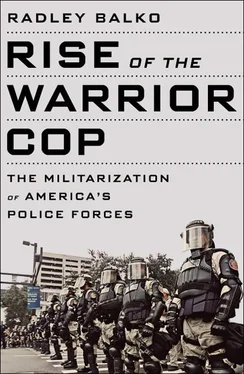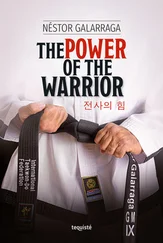Since Nixon had campaigned and staked his reelection hopes on reducing crime, and since crime policy and police procedures were primarily local issues, he had a strong interest in seeing that the states adopted his plan. That was one reason for expanding the LEAA. Local police agencies were likely to be more receptive when they got free stuff in exchange for their cooperation. He also came up with a piece of model legislation based on his federal bills—no-knock, preventive detention, wiretapping, and so on—that state legislatures could pass to show they were allies in the national fight. He told Congress that he had instructed his Justice Department to host a number of drug policy conferences across the country, where federal and local narcotics officers could exchange information and tactics. 76Nixon also addressed the demand side with a number of rehabilitation and treatment programs. (The next year the administration would even fund a methadone program in Washington, DC, run by addiction specialist Robert DuPont. 77)
In a few areas, Nixon could move immediately, without waiting for money or authorization from Congress. One such area was border enforcement. On September 21, 1969, the Nixon administration launched Operation Intercept, under the direction of G. Gordon Liddy. Every vehicle crossing into the United States was to be thoroughly searched by US Customs agents. The agents were told to search each car for a minimum of three minutes, including trunks, glove compartments, bags, and underneath seats.
For all practical purposes, the operation shut down the border. The resulting lines slowed trade to a crawl. It was an extreme, hostile policy, the sort normally implemented by countries in times of war. It proved so unpopular on both sides of the border that Nixon rolled it back two weeks after it began. But the effort sent a signal to federal, state, and local law enforcement, in Customs and elsewhere, that marijuana was as serious a threat to US interests as spies, revolutionary infiltrators, and enemy combatants—the sorts of threats that would normally move the government to such an extreme crackdown at the border.

ON OCTOBER 3, 1969, SEVEN NARCOTICS AGENTS STORMED apartments B and D at 8031 Comstock Avenue in Whittier, California, in a predawn, no-knock raid. Two officers were from the California State Bureau of Narcotics, four were from the Los Angeles County Sheriff’s Department, and the last was Det. Sgt. Frank Sweeney, a police officer from the tiny nearby town of Vernon. In apartment B, fifty-year-old Florence Mehan was asleep with her twelve-year-old daughter Susan.
“I saw three men,” Mehan told the Los Angeles Times . “One of them grabbed me by the arm. I screamed and I ran out. I thought they were going to attack me.” Susan said, “They just grabbed Mommy and said they had a search warrant to look for marijuana.”
The officers had raided the wrong apartment. Their search warrant was for apartments B and D at 8033 Comstock Avenue. Those apartments were both on the second floor.
Mehan’s other daughter, Linda, who was twenty-three, lived on the second floor—though not in either of the targeted apartments—along with her husband, twenty-two-year-old Heyward Dyer and their twenty-two-month-old son Francis. Heyward Dyer awoke to the screaming and commotion from the mistaken raid in his mother-in-law’s apartment, went downstairs to investigate, and was confronted by several police officer guns aimed in his direction.
The narcotics team eventually realized that they had raided the wrong apartment. They immediately left to raid apartments B and D on the second floor. In the meantime, Linda Dyer—seven months pregnant at the time—was also awakened by the noise. She went downstairs with Francis to check on her mother and sister. At some point she handed the baby to her husband.
As the police raided apartment B, Det. Sgt. Sweeney somehow mistakenly fired his .223-caliber rifle into the floor. The bullet ripped through the floor, then through the ceiling of the apartment below, where Heyward Dyer was standing, holding his son. The bullet pierced Dyer’s skull, killing him instantly. As his father fell, the infant Francis Dyer went crashing to the floor.
From press accounts, the police never made clear why a police officer from Vernon went along for a raid in Whittier, and why he was carrying a rifle when neither the California Bureau of Narcotics—which directed the raid—nor the Los Angeles County Sheriff’s Department allowed it. Police agencies were (and still are) also supposed to notify any agency with overlapping jurisdiction during such raids, in part because local departments—especially in small towns—tend to have local knowledge. One example would have been knowing that this apartment complex had an odd way of assigning addresses. No such notification ever happened. The police did arrest one man in apartment D for possession of “two red capsules” and “two white capsules” believed to be illegal narcotics, along with 150 marijuana seeds.
By 1969, California was one of twenty-five states that had a no-knock law. Of course, Los Angeles County was also where Ker v. California had originated, the case in which the US Supreme Court six years earlier had (mostly) given its stamp of approval to the “destroying evidence” exception to the knock-and-announce rule, and William Brennan had warned of the consequences of such a dangerous precedent.
Though Nixon wouldn’t officially “declare war” on drugs until 1972, the modern drug war effectively began with his inauguration in 1969. It seems likely, then, that Heyward Dyer was the modern drug war’s first innocent fatality. There would be more. Many, many more. 78
FIVE YEARS OF UNREST AND INCREASINGLY MILITARIZED police actions culminated with America’s very first SWAT raid in the final months of the 1960s. The December 1969 raid on the Los Angeles headquarters of the Black Panthers was also about as high-profile a debut for Daryl Gates’s pet project as he could possibly have imagined. Practically, logistically, and tactically, the raid was an utter disaster. But in terms of public relations, it was an enormous success.
The Black Panther Party hit its peak in 1969. Started in Oakland just three years earlier by Huey Newton and Bobby Seale, the activist group’s mix of Marxism, militance, and black nationalism quickly found a following in the counterculture. Panthers often espoused their revolutionary rhetoric and illustrated their “by any means necessary” motto by toting loaded rifles and handguns during public protests and demonstrations. It wasn’t just talk. In a little over three years, nine police officers and ten Panthers had died in police-Panther confrontations across the country. By 1969, the group was ten thousand strong and had become a bright, blinking flash point on the radar of police in every city in which it had established a presence. FBI director J. Edgar Hoover had made the Black Panthers a top priority and, naturally, had publicly “declared war” on them. 79
There are conflicting accounts of the events that led up to the Panther SWAT raid. According to Gates’s autobiography, sometime before the final confrontation, LAPD captain Ted Morton received a complaint from a woman about noise coming from a loudspeaker in a building occupied by the Panthers. When Morton went in to investigate, he was greeted with several guns and warned to leave immediately. Morton returned to the police station and wrote up a report, and within a few days Gates and the LAPD brass began drawing up plans to raid the building on charges of assaulting a police officer with a deadly weapon. 80
Читать дальше













